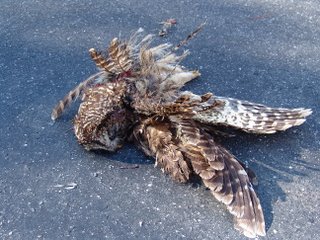
We do not have any numbers regarding the number of animals killed along roads in and around Four Holes Swamp, but over the years it is obvious that roads are a deadly hazard to many of the species that reside in the swamp. The larger animals usually attract our attention as why drive by, but certainly smaller animals, including birds, suffer similarly when they make contact with a fast-moving vehicle.
On the drive from Summerville to the Francis Beidler Forest along U.S. Hwy 78, U.S. Hwy 178, Beidler Forest Rd., and Mimms Rd., we have seen deer, a bobcat, an otter, numerous Barred Owls, various snakes, raccoons, opossums, a coyote, a beaver, a turkey, rabbits, squirrels, turtles, hawks, domestic ducks, a and Gray Fox dead along the road. Today, we collected a dead
Barred Owl along Beidler Forest Road and were able to salvage both talons and wings for use in our education program. We would much prefer to see the owl in the swamp while leading a group around the boardwalk.
Roads are not a natural part of the environment and can cause animal mortalities when they cross established migratory routes or fragment animal habitat. Unfortunately, roads can also be attractive to animals. The grassy right-of-ways along roads and under power lines that often parallel roads provide suitable food for a variety of rodents. Rodents are prey items for larger animals that can become fixated on their prospective meal and oblivious to vehicles approaching a great speed. Additionally, power line poles and trees at the edge of the right-of-ways provide excellent observation posts for birds of prey to survey the open areas along the road. Once they spot their prey and begin their attack glide, they will often cross the road at a height consistent with that of a passing vehicle.
More roads increase the fragmentation of habitat while increased traffic proportionally increases the number of animals killed by collisions with vehicles. In the short term, we can slow down and remain alert as we drive. However, in the future, if we hope to have sufficient habitat and animals living in that habitat, we will need to consider alternatives to more roads as a solution to increasing traffic.

















